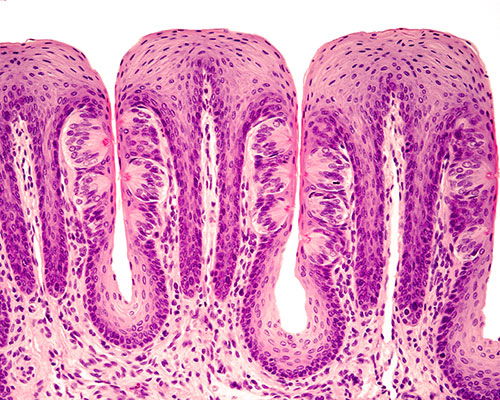Your Terrific Tongue
Licking an ice cream cone. Talking with your friends. Chewing bubblegum. Whistling. You don’t even think about it, but your tongue helps you do all these things. Your tongue is an amazing tool specially designed by God to help you all day, every day, in a variety of ways.
That’s Some Strength!
Your tongue is made up of eight muscles that allow you to move it in different ways. Those muscles work together so you can push food around in your mouth, swallow, and breathe. And your tongue never takes a rest. Even when you’re sleeping, your tongue is working by moving saliva to the back of your throat so you don’t drool on your pillow all night!
No Two Are Alike
Like snowflakes, you may have heard that no two fingerprints or eye irises are the same. But did you know that everyone has a unique tongue print? Each person’s tongue has a shape and surface texture that is different from anyone else’s—even identical twins.
Mmmm . . . Tasty
Your tongue is covered with hundreds of incredible little bumps known as papillae (puh-PILL-ee). These bumps are filled with nerves that are sensitive to touch and temperature. Depending on their size and location, each papillae holds from 5 to 100 taste buds. In total, the average person has around 2,000 to 10,000 taste buds.
Did You Know?
Your tongue replaces old taste buds with new ones about every 10 days.

Ever wonder what taste buds look like under a microscope? Well, now you know!
The Big Five
Taste buds detect five major taste categories that humans experience when they eat and drink food. Your tongue recognizes these basic tastes, combinations of these tastes, and even up to 10 levels of intensity for each taste. With all of these possibilities, you can detect over 100,000 different flavors!
The taste buds on the tip and sides of your tongue are sensitive to all five tastes, which is why you can enjoy salty fries, sweet cherry pie, or candy that’s so sour it makes your mouth pucker. The back of your tongue is especially sensitive to anything that tastes bitter, causing you to gag if you eat food that has spoiled. This safety feature keeps you from swallowing foods that could be bad for you. After Adam and Eve sinned in the garden of Eden, death and danger entered the world, including poison, sometimes found in foods. But we can be thankful that God has designed us with “safety features” like these to help keep us healthy in a fallen world.
Taste & Smell Teamwork
Have you ever noticed that when you have a stuffy nose you don’t taste food as well? That’s because your brain receives taste signals from both your tongue and your nose.
Whenever you eat or drink, the taste buds on your tongue send messages to your brain through your nervous system. As you chew, you also release chemicals from food in the back of your throat. Those chemicals travel to your nose and then pass to your brain. The tongue’s taste messages and the nose’s chemical signals combine to explain to your brain how something tastes.
Did You Know?
Brushing your tongue when you brush your teeth can help prevent bad breath.
Did You Know?
Taste buds aren’t found only on your tongue. They’re also on the inside of your cheeks, lips, and roof of your mouth.
Try This!
Shut your eyes and pinch your nose. Have a parent feed you a small piece of food. While still pinching your nose, chew the food and see if you can identify the flavor.
While your eyes are still shut, release your nose so your brain can receive additional taste information.
Were you able to guess the food? Did temperature and texture help you guess? Was it harder to guess when your nose was pinched?
Check It Out
When God made Adam and Eve in his image in the garden of Eden, he gave them an incredible gift that no animal has—the gift of language. God says that the power of life and death is in our tongue (Proverbs 18:21). That’s a lot of power for such a small part of our body. That’s why God gave us instructions for how to use our tongues. In the book of Ephesians, God had Paul write about the right way to use our tongues:
“Let no corrupting talk come out of your mouths, but only such as is good for building up, as fits the occasion, that it may give grace to those who hear.” (Ephesians 4:29)
And in the Psalms, we are told how to guard against the wrong way:
“Keep your tongue from evil and your lips from speaking deceit.” (Psalm 34:13)
Whenever you speak, you can use your words for good—speaking words of biblical truth and love—or for evil—saying mean, unkind things that hurt others. Ask God to help you use your tongue as a tool to bless others for his glory.
Tongues in the Animal Kingdom
God also created some incredibly unique animal tongues! Originally, in the garden of Eden, humans and animals would have only eaten fruits and plants. But in his infinite knowledge, God gave many animals amazing tongues that would allow them to thrive even after sin and death entered the world. From squeegees to fishhooks to sticky traps, let’s take a look at some of these wiggly wonders of the animal kingdom.
Fishhook Spikes
A penguin’s tongue can taste only two flavors—sour and salty.
Penguins don’t have teeth, but it sure looks like their tongues do! A penguin’s tongue is covered in bristly spikes made of keratin (the same material your hair is made of). All the spikes point backward in the penguin’s mouth and act like little fishhooks, helping move the penguin’s fishy dinner toward the back of its throat so it can swallow the wriggly meal.
Super Squeegee
Like the okapi, giraffes, polar bears, and chow chow dogs have black tongues.
Washing your face might not be the most fun task, but at least you don’t have to lick it clean! The okapi keeps its face clean by using its twisty, black tongue to lick its eyes, ears, and nostrils. An okapi’s flexible tongue can be over 14 inches long—long enough to swat insects away from its neck and shoulder blades! No one knows for sure why an okapi’s tongue is black, but some people believe the purplish-black color is a natural form of sunblock.
Sticky Bug Trap
Pangolins use their sticky tongues to eat up to 70 million insects every year.
Can you imagine having a tongue that could reach to the floor? The pangolin is a unique mammal with a tongue that is so long, it’s connected near the bottom of its rib cage, instead of starting in its mouth, like a human tongue. This means that a pangolin’s tongue can be as long as its body (minus its tail). Because they don’t have any teeth, pangolins use their long, sticky tongues to pick up ants and other insects and swallow them whole.
Poison Prank
The back of the blue-tongued skink’s tongue is ultraviolet blue, meaning there’s more color to its tongue than humans can even see!
Have you ever eaten ice cream that turned your tongue blue? Imagine your tongue staying that color forever! For the blue-tongued skink, that’s reality. This lizard has a candy-pink mouth with a tongue that looks like it’s been dipped in blue paint. The bright color scares predators away because they are tricked into thinking the lizard is poisonous, when really, it’s harmless.
How many taste buds do you have?
- Pigeons up to 59
- Giraffes up to 200
- Chickens up to 360
- Lions up to 470
- Humans up to 10,000
- Rabbits up to 17,000
- Cows up to 25,000
- Catfish up to 175,000
Kids Answers Magazine
Your Terrific Tongue
Talking, tasting, swallowing, even whistling—your tongue does amazing things every day.
Browse Kids Issue- © 2025 Answers in Genesis
- Privacy Policy
- Contact
- About

